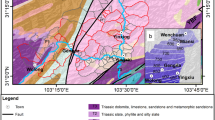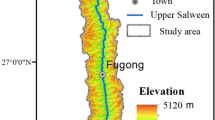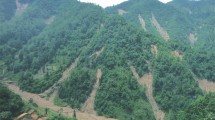Abstract
Debris flows are more frequent in central Taiwan, because of its mountainous geography. For example, many debris flows were induced by Typhoon Herb in 1996. The Chi-Chi earthquake with a magnitude of 7.3, which took place in 1999 in central Taiwan, induced many landslides in this region. Some landslides turned into debris flows when Typhoon Toraji struck Taiwan in 2001. This study investigates the characteristics of the gullies where debris flows have occurred for a comparison. Aerial photos of these regions dated in 1997 (before the earthquake) and 2001 (after the earthquake) are used to identify the occurrence of gully-type debris flows. A Geographic Information System (GIS) is applied to acquire hydrological and geomorphic characteristics: stream gradient, stream length, catchment gradient, catchment area, form factor, and geology unit of these gullies. These characteristics in different study regions are presented in a statistical approach. The study of how strong ground motion affects the debris flows occurrence is conducted. The characteristics of the debris flow gullies triggered by typhoons before and after the Chi-Chi earthquake are quantitatively compared. The analysis results show that a significant transformation in the characteristics was induced by the Chi-Chi earthquake. In general, the transformation points out a lower hydrological and geomorphic threshold to trigger debris flows after the Chi-Chi earthquake. The susceptibility of rock units to strong ground motion is also examined. The analysis of debris flow density and accumulated rainfall in regions of different ground motion also reveal that the rainfall threshold decreases after the Chi-Chi earthquake.











Similar content being viewed by others
References
Bilham R, Yu TT (2000) The morphology of thrust faulting in the 21 of September 1999, Chi Chi, Taiwan earthquake. J Asian Earth Sci 18:351–367
Carro M, De Amicis M, Luzi L, Marzorati S (2003) The application of predictive modeling techniques to landslides induced by earthquakes: the case study of the 26 September 1997 Umbria–Marche earthquake (Italy). Eng Geol 69(1):139–159
Central Weather Bureau (1999) http://www.scman.cwb.gov.tw/eqv3/eq_report/special/19990921/921isomap.GIF. Accessed 2000
Central Geological Survey (1974) Geologic map of Taiwan, 1:250,000, Central Geological Survey. M.E.A., Taiwan
Chang TY (2001) Comparative study of the locations of landslides induced by rainfall and by earthquake, Master Thesis, Taiwan University, Taiwan (in Chinese)
Chen TC (2005) Landslides induced by heavy rainfall for 5 years after Chi-Chi earthquake, Taiwan. Geophys Res Abstr 7, 08637
Chen H, Petley DN (2005) The impact of landslides and debris flows triggered by Typhoon Mindulle in Taiwan. Q J Eng Geol Hydrogeol 38:301–304
Chen CC, Tseng CY, Dong JJ (2007) New entropy based method for variables selection and its application to the debris-flow hazard assessment. Eng Geol 94:19–26
Chen SC, Liao WH (2006) The landslide and sediment delivery change in the Da-Jia River after earthquake (Taiwan). Geophys Res Abstr 8, 07843
Coe JA, Godt JW (2001) Debris flows triggered by the El Niño rainstorm of February 2–3, 1998, Walpert Ridge and vicinity, Alameda County, California. US Geol Misc Field Studies Map MF-2384
Dong JJ, Lee WR, Lin ML, Huang AB, Lee YL (2008) Effects of seismic anisotropy and geological characteristics on the kinematics of the neighboring Jiufengershan and Hungtsaiping landslides during Chi-Chi earthquake. Tectonophysics. doi:10.1016/j.tecto.2007.11.008
Ellen SD, Cannon SH, Reneau SL (1988) Distribution of debris flows in Marin County. Landslides, floods, and marine effects of the storm of January 3–5, 1982, in the San Francisco Bay region, California: U.S. Geological Survey Professional Paper 1434:113–131
Esposito E, Porfido S, Simonelli AL, Mastrolorenzo G, Laccarino G (2000) Landslides and other surface effects induced by the 1997 Umbria–Marche seismic sequence. Eng Geol 58:353–376
Ho CS (1988) An introduction to the geology of Taiwan explanatory text of the geologic map of Taiwan. 2nd ed. Central Geological Survey, M.E.A., Taiwan
Ho MS (2003) Study of occurrence characteristics of slope debris flows in central Taiwan, Master Thesis, Taiwan University, Taiwan (in Chinese)
Hung JJ (2000) Chi-Chi earthquake induced landslides in Taiwan, In: International workshop on annual commemoration of Chi-Chi earthquake. Taipei, pp 23–36
Keffer DK (1984) Landslides caused by earthquakes. Geol Soc Am Bull 95:406–421
Khazai B, Sitar N (2003) Evaluation of factors controlling earthquake-induced landslide caused by Chi-Chi earthquake and comparison with the Northridge and Loma Prieta. Eng Geol 71(1):79–95
Kuo FY (2003) Study of characteristics of debris flows before and after 921 Chi-Chi earthquake in Nantou region, Master Thesis, National Chi-Nan University, Taiwan (in Chinese)
Lin ML, Jeng FS (2000) Characteristics of hazards induced by extremely heavy rainfall in central Taiwan-typhoon Herb. Eng Geol 58(2):191–207
Lin ML, Tung CC (2003) A GIS-based potential analysis of the landslides induced by the Chi-Chi earthquake. Eng Geol 71(1):63–77
Lin PS, Lin JY, Hung JC, Yang MD (2002) Assessing debris-flow hazard in a watershed in Taiwan. Eng Geol 66(3):295–313
Lin CW, Shieh CL, Yuan BD, Chieh TC, Liu CH, Lee SY (2003) Impact of Chi-Chi earthquake on the occurrence of landslides and debris flows: example from the Chenyulan river watershed, Taiwan. Eng Geol 71(1):49–61
Lin CW, Lee SY, Huang ML (2006) The empirical rainfall thresholds to trigger debris flows in Central Taiwan after 1999 Chi-Chi earthquake. Geophys Res Abstr 8, 02775
Shin TC (2000) Some seismological aspects of the 1999 Chi-Chi earthquake in Taiwan. TAO 11:555–566
Tien KK, Lee DH, Lui CY (2000) Disaster conditions and failure characteristics of road slope in Ah-Li-Shan after Chi-Chi earthquake. Proceedings of annual commemoration of Chi-Chi earthquake, Taiwan, 373–396 (in Chinese)
Van Dine DF (1985) Debris flow and debris torrents in the Southern Canadian Cordillera. Can Geotech J 22:44–68
Wang WN, Wu HL, Nakamura H, Wu SC, Ouyang S, Yu MF (2003) Mass movements caused by recent tectonic activity: the 1999 Chi-Chi earthquake in central Taiwan. Island Arc 12(4):325–334
Wieczorek GF, Sarmiento J (1988) Rainfall, piezometric levels, and debris flows near La Honda, California, in storms between 1975 and 1983. Landslides, floods, and marine effects of the storm of January 3–5, 1982, in the San Francisco Bay region, California: US Geological Survey Professional Paper 1434:43–62
Author information
Authors and Affiliations
Corresponding author
Rights and permissions
About this article
Cite this article
Liu, CN., Huang, HF. & Dong, JJ. Impacts of September 21, 1999 Chi-Chi earthquake on the characteristics of gully-type debris flows in central Taiwan. Nat Hazards 47, 349–368 (2008). https://doi.org/10.1007/s11069-008-9223-9
Received:
Accepted:
Published:
Issue Date:
DOI: https://doi.org/10.1007/s11069-008-9223-9




